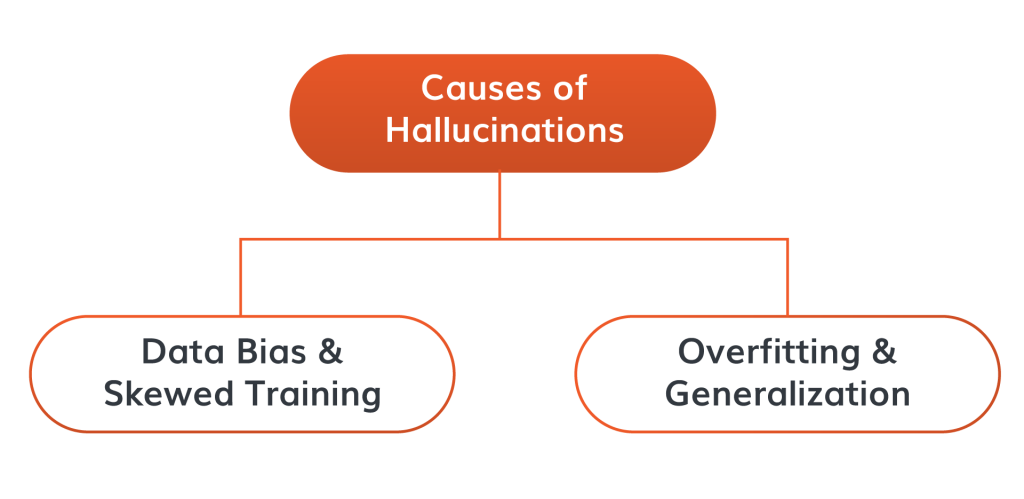Share this Post
Generative AI has undeniably revolutionized art, language, and creativity. However, amidst its remarkable achievements lies a fascinating and perplexing phenomenon known as “hallucination.” In this blog, we will delve into AI hallucinations, exploring their definition, causes, real-world examples, impacts on decision-making, challenges in detection, ethical implications, and mitigation strategies.
What are AI Hallucinations?
In the context of AI, hallucinations refer to perceptual distortions akin to illusory perceptions in human psychology. In generative AI, these hallucinations manifest as outputs that appear creative or coherent but lack a logical or factual basis, often deviating from the intended input or task.
What are the causes of AI Hallucinations?

- Data Bias & Skewed Training: AI models are only as good as the data that trains them. Biases and skewed training data can lead to hallucinations, as models may inadvertently replicate and exaggerate these biases in their outputs.
- Overfitting & Generalization: Overfitting occurs when AI models become too closely synced with the training data, resulting in a lack of generalization. It can lead to hallucinations as the model fails to produce diverse and contextually relevant output.
Impact of AI Hallucinations on Decision-Making
- Confidence in Incorrect Outputs: Hallucinations can lead to unwarranted confidence in AI-generated outputs, potentially causing individuals or organizations to make decisions based on unreliable information
- Unintended Consequences: AI hallucinations can have far-reaching consequences, from misinterpreting medical scans to generating biased content, thereby amplifying societal prejudices and misconceptions.
Challenges in Detecting and Minimizing AI Hallucinations
- Interpretability: The inherent complexity of AI models poses challenges in understanding how hallucinations occur and devising effective mitigation strategies.
- Data Quality Assurance: Ensuring high-quality, bias-free training data and ongoing data monitoring is essential but often challenging.
Ethical Implications of AI Hallucinations
- Accountability & Responsibility: As AI increasingly influences decision-making, accountability for AI hallucinations becomes paramount. Developers, organizations, and regulators must navigate the ethical terrain.
- Transparency & Consent: Individuals should be aware of AI’s potential to generate hallucinatory content, ensuring informed consent when interacting with AI-generated outputs.
- Implications on Fairness: AI hallucinations can exacerbate societal inequalities and biases. Addressing fairness and equity concerns is essential to mitigate these effects.
Mitigation Strategies for AI Hallucinations

- Regular Auditing & Validation: Frequent audits and validation of AI systems can help identify and rectify hallucination-prone behavior.
- Adversarial Testing: Conducting adversarial tests with intentionally exposed models to challenge inputs can help reveal vulnerabilities and improve robustness.
- Robust Training & Validation: Enhanced training practices, including diverse datasets and sophisticated model architectures, can reduce hallucination risk and improve generalization.
Ethical AI and Hallucinations
Ethical AI encompasses principles that ensure AI systems operate in ways that are fair, just, and aligned with human values. When it comes to AI hallucinations, several ethical considerations come into play:
Pros
- Creativity: AI’s capacity for hallucinations can lead to unexpected but appealing, innovative, and artistic outputs, expanding the creative landscape.
- Enhancing Human Innovation: AI can be a collaborative tool for human creators, augmenting their abilities and sparking new ideas.
Cons
- Misinformation: Hallucinatory outputs may convey false or misleading information, impacting decision-making in various domains.
- Bias Amplification: AI hallucinations can perpetuate biases in the training data, leading to unjust or discriminatory content.
- Lack of Accountability: Determining responsibility for AI-generated hallucinatory content can be challenging, blurring lines of accountability.
Output of Results and Ethical Dilemmas
AI hallucinations often generate content that falls into ethical gray areas:
- Misleading Content: Hallucinations can produce content that appears factual but lacks empirical evidence, potentially leading users astray. It raises questions about the responsible dissemination and consumption of AI-generated information.
- Offensive or Harmful Content: AI may inadvertently generate offensive, harmful, or objectionable content. Ethical AI should ensure that content adheres to acceptable standards of decency and respect.
- Biased Content: Bias in AI training data can lead to biased hallucinatory content, reinforcing stereotypes or inequalities. Ethical AI requires addressing and mitigating these biases.
The Crucial Role of Human Touch in AI
While AI has made significant strides, human oversight remains essential in managing AI hallucinations:

- Quality Control: Human reviewers can assess and filter AI-generated content, ensuring it aligns with ethical standards.
- Contextual Understanding: Humans possess contextual knowledge and cultural awareness that AI lacks, enabling them to evaluate the appropriateness of content.
- Adaptation and Improvement: Human feedback and intervention help AI models learn and adapt, reducing the occurrence of hallucinations over time.
Striking a Balance between AI and Ethical Guidelines
The challenge is not to eliminate AI hallucinations but to strike a balance where AI creativity flourishes within ethical boundaries. This balance involves:
- Ethical Guidelines: Establishing clear ethical guidelines for AI development and deployment, focusing on transparency and accountability.
- Human-AI Collaboration: Promoting collaboration between AI systems and human experts or creators to ensure that outputs are coherent, ethical, and contextually relevant.
- Continuous Monitoring: Implementing constant monitoring and auditing of AI systems to promptly detect and rectify hallucinatory content.
AI hallucinations are a fascinating yet complex aspect of generative AI. Understanding their causes, impacts, and ethical implications is essential as we integrate AI into various aspects of society. By developing robust mitigation strategies and maintaining vigilance, we can harness the creative power of AI while minimizing its propensity for hallucinatory outputs, thereby responsibly and ethically advancing both the technology and society.
Author:
 Abhijeet Phadnis serves as the Global PreSales Head, bringing robust Project/Program management expertise and a solid technical understanding to drive the successful implementation of large-scale enterprise initiatives. With a proven track record, he has played a pivotal role in assisting leading Fortune 500 companies in optimizing their business operations. Abhijeet is an avid AI/ML enthusiast and a seasoned Data Scientist passionate about emerging technologies such as Generative AI.
Abhijeet Phadnis serves as the Global PreSales Head, bringing robust Project/Program management expertise and a solid technical understanding to drive the successful implementation of large-scale enterprise initiatives. With a proven track record, he has played a pivotal role in assisting leading Fortune 500 companies in optimizing their business operations. Abhijeet is an avid AI/ML enthusiast and a seasoned Data Scientist passionate about emerging technologies such as Generative AI.


